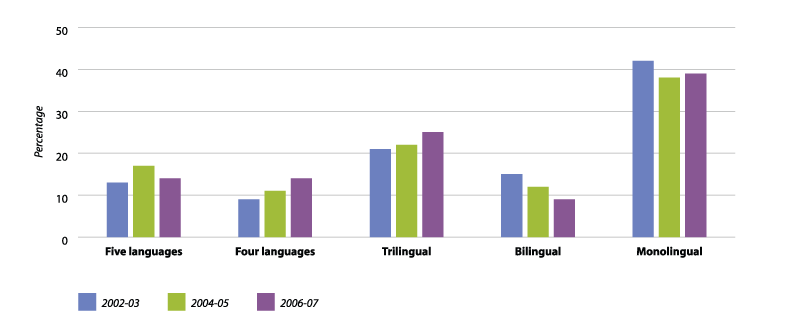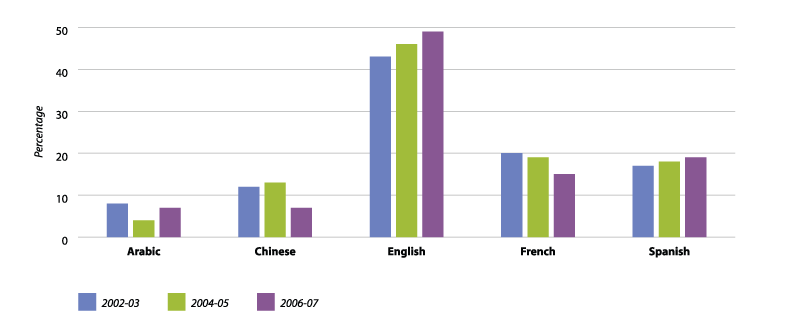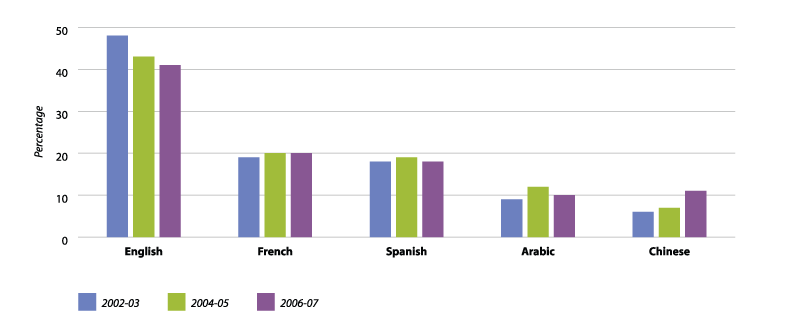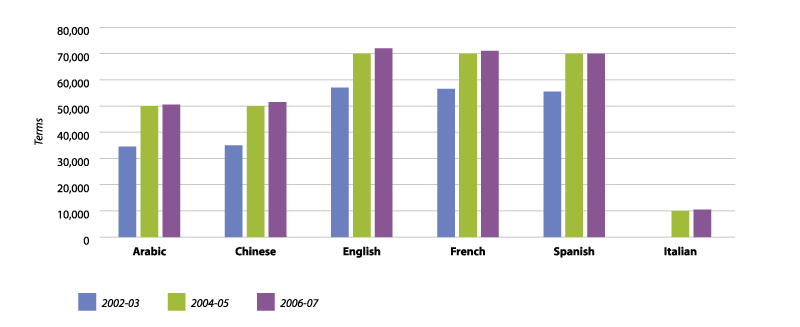F. FAO Language Policy
324. In 1999, the 30th FAO Conference reaffirmed "the imperative of ensuring parity and balance in the use of all FAO languages and the need for supervision of the quality of translation and interpretation. In looking forward to further improvements in the future, the Conference agreed to the need for Members to monitor progress closely through periodic follow up and evaluation ".
a) FAO meetings
325. The number of PWB approved sessions in 2006-07 represented a 16% decline compared to 2004-05. Unscheduled and cancelled sessions also declined resulting in a total of 229 sessions being carried out in 2006-07 compared to 263 in 2004-05, a 13% reduction.Table 18: Sessions held at headquarters and in decentralized locations
| Description | 2002-03 | 2004-05 | 2006-07 |
|---|---|---|---|
| Sessions approved in PWB | 232 | 231 | 193 |
| Cancelled Sessions, Regular Programme | 6 | 62 | 23 |
| Unscheduled Sessions, Regular Programme | 26 | 27 | 25 |
| Unscheduled Sessions, Trust Funds | 12 | 67 | 34 |
| TOTAL | 264 | 263 | 229 |
| Headquarters | 101 | 115 | 92 |
| Decentralized locations | 163 | 148 | 137 |
| TOTAL | 264 | 263 | 229 |
| Percentage decentralized meetings | 62% | 56% | 60% |
326. An indicator of language balance for FAO meetings is the percentage of meetings held in all FAO languages (Figure 16). In 2006-07, the percentage of meetings held in five languages decreased to 14%, while the percentage of meetings in four languages increased to 14%, the combined 28% of all meetings was similar to 2004-05. The percentage of meetings held in three languages increased to 25%. Overall, meetings in more than two languages increased to 52% compared to 50% in 2004-05.
Figure 16: Proportion of meetings by number of languages (%)

b) Publications
327. Publication of documents in FAO’s languages continued to be a major priority for the Organization. All flagship titles were made available in the five languages with versions of more technical titles being published in languages appropriate to the needs of key target audiences.
328. The 2006-07 biennium saw some fluctuation in the percentage of titles issued in various languages (Figure 17). The proportion of publications in English increased from 46% in 2004-05 to 49% in 2006-07, Arabic increased from 4% to 7% and Spanish increased from 18% to 19%. Conversely, the proportion of publications in Chinese declined from 13% in 2004-05 to 7% in 2006-07, mainly due to reduced production during the second year of the biennium, while arrangements for the FAO Chinese Publishing Programme were re-negotiated with the Chinese Ministry of Agriculture. The proportion in French also declined, from 19% to 15%. In anticipation of Russian becoming an official language in 2008, documents published in Russian in 2006-07 accounted for about 3% of total publications.
Figure 17: Priced and main publications by language

c) Electronic material (WAICENT and the FAO Internet site)
329. The World Agricultural Information Centre (WAICENT) continued to improve its language coverage both for Web sites and electronic documents. Through document scanning and OCR activities, additional content in Arabic and Chinese was added to the Corporate Document Repository (CDR) and the proportion of information disseminated in those languages increased. The introduction of new Web publishing tools (Content Management Systems) facilitated the preparation and management of Web content in multiple languages, especially Arabic and Chinese. The FAO Corporate Document Repository language content is shown in Figure 18. In 2006-07, 41% of its content was in English, down from 48% in 2002-03, while Chinese content increased from 6 percent in 2002-03 to 11 percent in 2006-07. Other languages remained relatively stable at about 20% for French and Spanish and 10% for Arabic.Figure 18: Corporate Document Repository content by language

330. Increased resources were dedicated to Web publishing activities within the "programme for improvement of language coverage" in 2006-07. This assisted in the evaluation and customisation of knowledge sharing platforms and new technology for Web publishing, increasing the number of Web sites and corporate portals in all FAO languages and facilitating the maintenance of the content.
331. The FAO Multilingual Thesaurus of Agricultural Terminology (AGROVOC) was made available on-line in 16 languages and work began on an AGROVOC "workbench" to manage the semantic content amongst different languages in order to make them coherently searchable. Work was also initiated on mapping AGROVOC to FAO's terminology information system, FAOTERM, in order to streamline the work of translators.
332. Users searching for information on the FAO Web site benefited from the Organization's corporate WAICENT framework, which efficiently managed the Organization's multilingual information and knowledge internally though information management systems such as the News and Events Management System (NEMS) and the Electronic Information Management System (EIMS). This facilitated decentralized access to multilingual information and knowledge through the FAO Knowledge Forum (Ask FAO, Best Practices and Knowledge Networks).
d) Terminology and language support
333. In 2006-07, the FAOTERM terminology database increased to more than 70,000 records in English, French and Spanish, and over 50,000 records in Arabic and Chinese, as well as about 10,000 records in Italian (Figure 19). Approximately 2,500 new terminology records were added to the database during the biennium. Further database management developments were carried out to incorporate full workflow capabilities. In addition, efforts were made to develop a Term Portal, providing an overall platform for terminology management and dissemination at the Organization level. This resulted in increased collaboration and contributions of FAO technical staff to terminology work. The level of usage of terminology data remained stable with about 300,000 queries each month, by an average of 12,000 users.Figure 19: Terms in FAOTERM by language

334. Translation and related work increasingly relied on computer-assisted translation technologies. In particular, translation memories, corporate multilingual document tools and the adaptation of working methods, enabled the search and retrieval of past translations to improve consistency of FAO’s documentation and expedite delivery of meeting documents.
e) Programme for the improvement of language coverage
335. Since the 2000-01 biennium, the Programme for the improvement of language coverage (funded within Programme 3J: Communications and Public Information in 2006-07) has provided central support for: investments having an immediate impact for countries at relatively low cost; creating the infrastructure for permanent capacity in the five official languages; and correcting long-standing deficiencies in language coverage. Expenditures for these purposes and to support the continuing arrangement for translation of documents into Chinese in cooperation with CAAS exceeded USD 994,000 in 2006-07.
336. Other expenditures included improved language coverage of FAO’s internal and external Web sites, audio and video productions and important publications, as well as language training. Investments in infrastructure included translation of HRMS training documentation and Project Cycle Overview into French and Spanish to permit HRMS deployment in regional offices. In anticipation of Russian becoming an official language of the Organization in 2008, the FAO newsroom and a terminology database were developed in Russian. Investments to correct long-standing deficiencies mainly concentrated on the translation of 20 additional titles into Arabic, continuing the effort initiated in 2004-05.